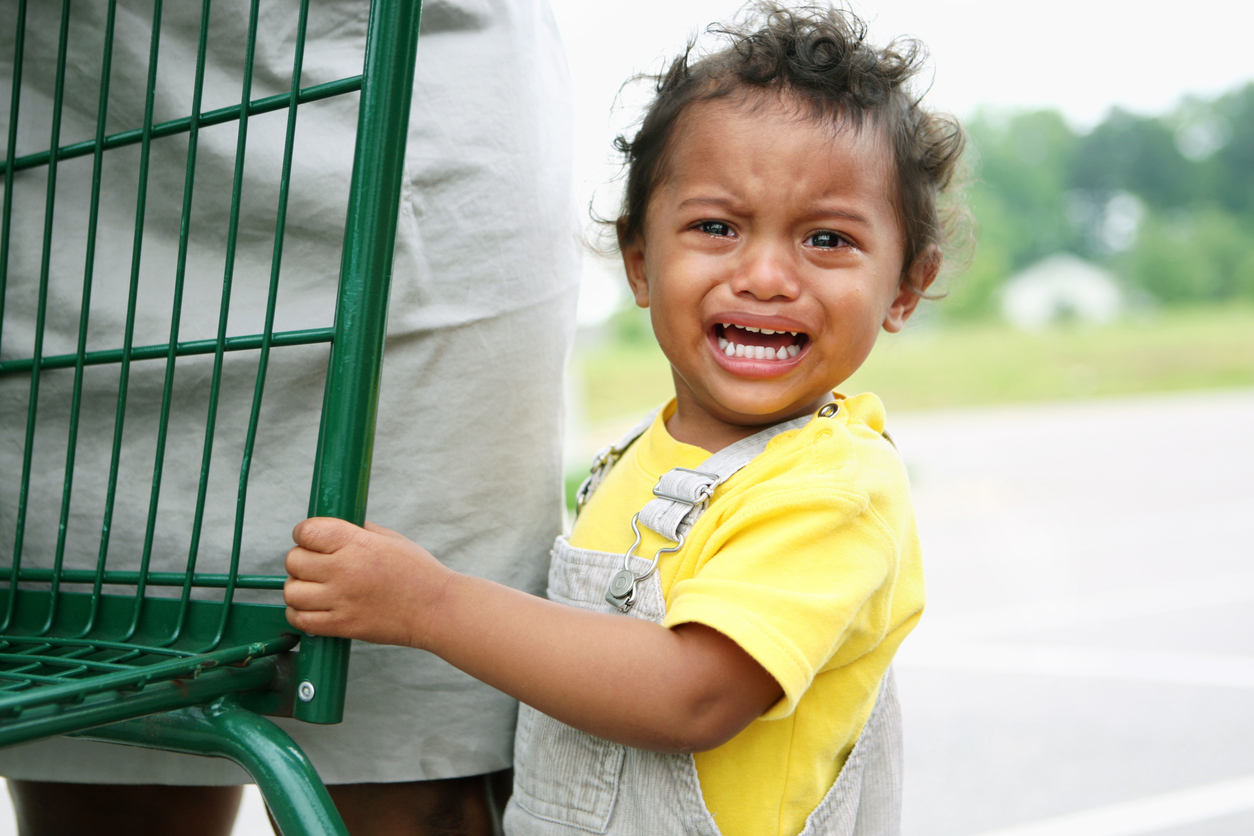
That said, you'll be glad to know that many tantrums are avoidable. Since a good number of outbursts result from the child feeling powerless, toddlers who feel they have some control over their lives have fewer tantrums. And since toddlers who are tired and hungry don't have the inner resources to handle frustration, managing your toddler's life so he isn't asked to cope when he's hungry or tired will reduce meltdowns. An ounce of prevention really is worth a pound of cure.
Here are my top research-based tips on how to prevent and handle those toddler tantrums.
1. Stay calm and re-connect.
Remember that once your toddler is upset, her brain isn't capable of calming her down. She needs a calm adult to soothe her so she can re-regulate. So when she feels disconnected or overwhelmed, your priority is to calm yourself, and reconnect with her. Researchers call this "co-regulation" meaning that your child is able to start to self-regulate because they connect to your calm.
2. Try to handle upsets so they don’t escalate.
It's amazing how acknowledging your child's anger can stop a brewing tantrum in its tracks. Anger doesn't begin to dissipate until it feels heard. Before you set a limit, acknowledge what your child wants.
"You wish you could have more juice, you love that juice, right?"
(Look, he's already nodding yes!) Then set the limit:
"You need to eat some eggs, too. We'll have more juice later."
(As you move his cup out of sight.) If he responds with anger, acknowledge it:
"That makes you so mad. You really want the juice."
Remember to keep your words pared down. It's hard for toddlers to follow language when they're upset.
"You are so mad!"
"No hitting."
3. Plan ahead to minimize Tantrum Triggers.
Since most tantrums happen when kids are hungry or tired, you can often avoid meltdowns if you think ahead. Preemptive feeding and napping, firm bedtimes, enforced rests, cozy times, peaceful quiet time without media stimulation -- all of which replenish your toddler's internal resources -- prevent most tantrums, and reground kids who are getting whiny. Learn to just say no -- to yourself! Don't squeeze in that last errand. Don't drag a hungry or tired kid to the store. Make do or do it tomorrow.
“I guess we can’t do a big shop today. We’ll just get the milk and bread and go home. And here’s a cheese stick to eat while we wait in line.”
4. Prevent tantrums by making sure your child has a full reservoir of your love and attention.
Kids who feel needy are more likely to tantrum. If you've been separated all day, make sure you reconnect with some roughhousing and laughter before you try to shop for dinner.
5. Prevent tantrums by sidestepping power struggles.
You don't have to prove you're right. Your child is trying to assert that he is a real person, with some real power in the world. That's totally appropriate. Let him say no whenever you can do so without compromise to safety, health, or other peoples' rights.
6. Learn to Emotion-Coach to help your child with strong emotions.
When your child gets angry, remember that anger is a defense against more uncomfortable feelings -- vulnerability, fear, hurt, grief. If you can help your child to notice those more vulnerable underlying feelings, the anger won't be needed as a defense, and will dissipate.
"You're mad! I hear that you wish we could stay at the playground.... It feels sad that we have to go now."
7. What NOT to do during a Temper Tantrum.
- Don't Ignore the tantrum. Your child is showing you that they don't have the internal resources to deal with the external world at the moment. They're communicating as well as they can at the moment. Whether you've said No to their request for a popsicle, or their tower keeps falling down, or it's time to leave the playground, it's more than they can handle, and tantrums are an age-appropriate way for them to express their upset. So don't ignore their outburst; they need to know you hear and understand and they aren't a bad person, just having a hard time.
- Don't yell, shout, or handle your child roughly. Yes, tantrums are stressful for us as parents, but you're the grown-up. It's your job to role-model how to handle challenging emotions in a patient and emotionally generous way.
- Don't worry; temper tantrums are completely age appropriate for toddlers and young children. Even when kids get older -- eight or nine -or fourteen! -- extreme stress can still provoke a tantrum.
8. What to do during a Temper Tantrum.
- Go ahead and set your boundary -- you do have to leave the playground and they can't have a popsicle right now. Just be kind about it, and express understanding that it isn't what they want.
- Do acknowledge their disappointment, sadness, and anger that things are not going as they wish right now.
- Let them know that they're safe, you're there, and you understand.
- If you can stay calm and loving, your child will gradually learn to express their frustration in more socially acceptable ways.
9. Create Safety to end a tantrum more quickly.
Think about what you feel like when you’re swept with exhaustion, rage and hopelessness. If you do lose it, you want someone to understand. You don't want them to get upset too. You don't want them to try to talk you out of your feelings. You want someone stronger to hold everything else together, reassuring you and helping you get yourself under control -- but only after you've had a good cry.
So when your child gets so upset that they erupt into a full blown tantrum, don't try to talk them out of it. Just stay close, even if he won't let you touch him. He needs to know you're there, and still love him. Be calm and reassuring. Don’t try to reason with him. Your goal is just to create safety, so he can let all those feelings come up. Once he gets a chance to show you his upset feelings, he'll feel, and act, a lot better.
After the tantrum, prevent the next one:
First, take some “cozy time” or quiet time together to reconnect and reassure. (No, you're not "rewarding" the tantrum. She needed this connection with you or she wouldn't have had the tantrum to begin with! And of course, as much as you can, make sure that your child gets enough “cozy time” with you that she doesn’t have to tantrum to get it.)
Second, tell the story of what happened, so that your child can understand and reflect, which builds the pre-frontal cortex:
"You were having such a good time playing at the playground...you didn't want to go home. When I said it was time to go, you were sad and mad...You yelled NO and hit me...Right? I said No Hitting! and you cried and cried.... I stayed right here with you and when you were ready we had a big, big hug.... Now you feel better. It's hard to leave the playground when you're having fun. It's okay to feel sad. You can tell me "SAD!" and I will understand. But no hitting; hitting hurts. And you know what? We can go to the playground again tomorrow and have fun. There is always more fun for us!"





